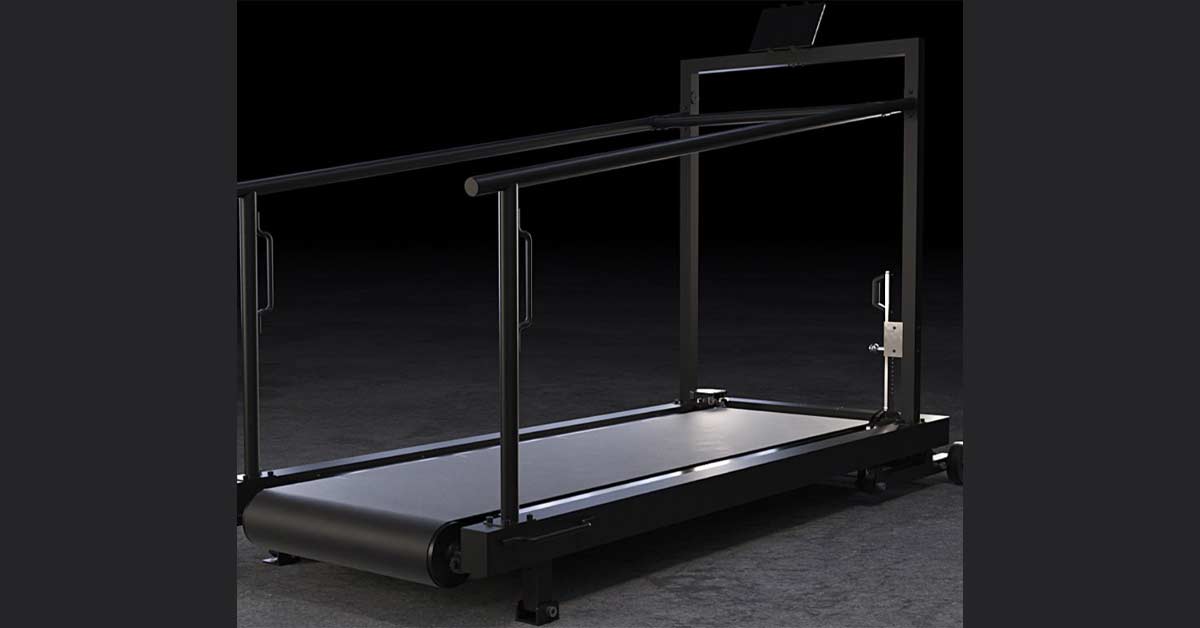I ventured into training in the private sector in the fall of 2020, working with groups of 1-8 athletes at a time. To my surprise, it was something I ended up enjoying. As an assistant track coach with a large roster of athletes, I am typically pulled in multiple directions with groups of 15-50, covering multiple events. Training in this new setting allowed me to work with much smaller groups with a common purpose (primarily speed). I found it to be a nice change of pace and I certainly feel that it has caused me to level-up in the craft of coaching.
In the winter of 2021, I knew that if I was going to continue training people out of my garage, I would need to invest in some sort of equipment which would allow for athletes to perform maximal (or near maximal) sprints. One problem with living near Chicago is that it gets pretty cold in the late fall and winter (and even on random days in the spring/summer). Weather can certainly serve as a guiding factor in regards to periodization, so the winter served as a nice time to focus on typical weight room qualities. However, that was not what all of my private clients needed, so I began thinking about which road I would go down. In true math teacher fashion, I created a table involving the devices I was considering:
- SHREDmill
- Variable resistance/assistance device (such as 1080 Sprint / Dynaspeed)
- Sprint treadmills (such as AssaultRunner Pro)
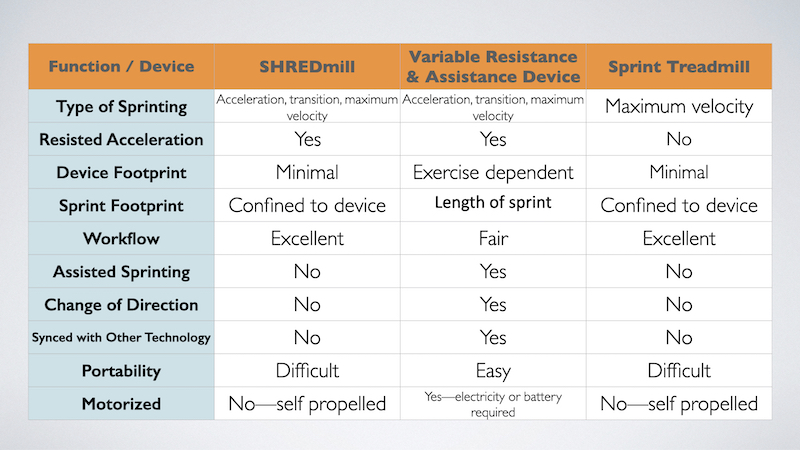
Each type of tool/technology comes with its own strengths and weaknesses. The transportability of the Dynaspeed made it very appealing to me, as it could have been used with the track athletes I coach in the spring (I would have gone with Dynaspeed over the 1080 Sprint because I already have a contact grid, and would have hoped to get a laser down the road). However, it would not be as functional for me in the cold months during private training in my garage due to lack of space.
Each type of tool/technology comes with its own strengths and weaknesses, says @HFJumps. Share on XCoincidentally, in the early spring of 2022, I learned that Tony Villani was in the process of increasing the production of the SHREDmill. Based on my constraints, the functionality of the device, and the insane results Villani, Matt Gates, and the rest of the XPE team have achieved at the NFL Combine, I made the decision to roll with the SHREDmill. Within this article, I will share some SHREDmill basics, my overall experience, and how I have used it in training.
Gears
If you walked into a room of trainers who use the SHREDmill, you would no doubt hear a reference to gears. The SHREDmill utilizes three main categories of sprints:
- Gear 2—High resistance, zero incline. Target is approximately 50% of an athlete’s maximum ground speed velocity. Villani refers to this as the “force” phase. Gear 2 reps are five seconds in duration and focus on improving steps two to five in a normal ground sprint.
Video 1. In Gear 2, the athlete stays in the same position for the duration of each rep, getting continuous reps simulating reps two through five in a sprint.
- Gear 3—Medium resistance, 10% incline. Target is approximately 75% of an athlete’s maximum ground speed velocity. Villani refers to this as the “force to form” phase. Gear 3 reps are traditionally five seconds in duration and focus on improving an athlete’s transition to maximum velocity.
Video 2. In Gear 3, the athlete completes six big “pushes” like Gear 2, but then slowly rises to just short of vertical by the end of the repetition.
- Gear 4—Low resistance, 15-20% incline. After an extensive introductory period, a possible goal is to get the athlete as close to their maximum ground speed as possible. Villani simply calls Gear 4 reps “form,” and he admits that athletes rarely hit their maximum ground speed on Gear 4 (hence why there is not a Gear 5 reference with the SHREDmill). Gear 4 probably has the most built-in flexibility, which goes along with athlete familiarity and their individual needs. Durations are typically five to ten seconds, but can go longer (excellent for track sprinters). To me, Gear 4 is like having a really long hill in the friendly confines of my garage.
Video 3. In Gear 4, the athlete gets the belt spinning to about seven miles per hour and then removes their hands from the rails and focuses on running with quality form. Once comfortable with Gear 4, the athlete can begin chasing top-end speed.
Functionality
A perk for me was the ability to address acceleration and maximum velocity mechanics with resistance in a small footprint (94” x 41” x 75” at highest point). The SHREDmill uses magnets to create an eddy current, which creates resistance based on the resistance setting (see Video 4) and the speed at which the user gets the belt to move. What is important about this is that the faster an athlete gets the belt to spin, the more resistance is created. This is a huge time-saver, because once the desired resistance is set, you can simply cycle athletes through—the magnets create the level of resistance that is required to hit the percentage of max speed desired. I will not say every rep is “just right,” but I think it is pretty darn close.
The SHREDmill uses magnets to create an eddy current, which creates resistance based on the resistance setting and the speed at which the user gets the belt to move, says @HFJumps. Share on XI have used all sorts of resistance devices and this is, without question, the easiest. No transporting weights and altering them for each athlete’s needs like one would do with a sled. No worrying about varying degrees of friction with sleds. No worrying about athletes getting a fourth degree burn with an Exer-Genie (no hate—I have four and use them often!). No worrying about a band snapping and an athlete face planting. No need to set up timing gates to see if athletes are hitting certain percentages of maximum velocity in their resisted runs. And, unlike the other items mentioned, it all happens in a 94” x 41” footprint with the SHREDmill.
Video 4. How to adjust the incline and magnetic resistance on the SHREDmill.
A common topic discussed amongst sport and strength and conditioning coaches is workflow. In my opinion, there is no better product on the market than the SHREDmill for resisted sprints when it comes to rate of athlete repetitions, quality of stimulus, consistency of desired resistance, and sprint footprint.
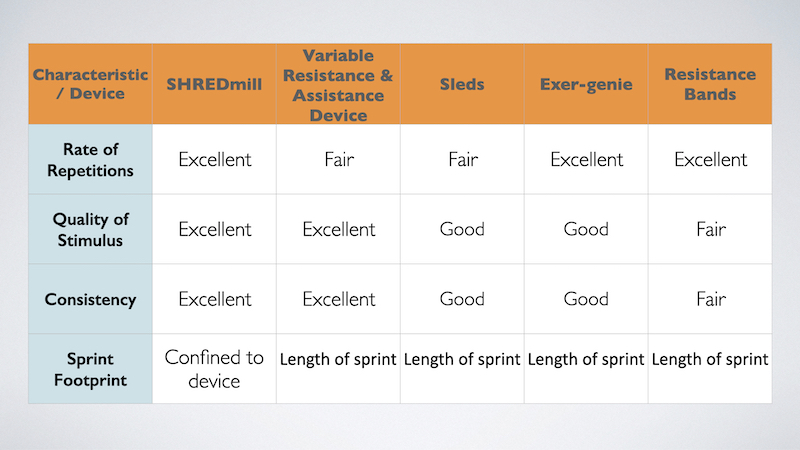
While variable resistance and assistance devices are the gold standard due to versatility and data captured, their workflows are well below the SHREDmill. For comparison, it is possible to get through a group of 40 athletes who each get 3 x 5 second sprints on the SHREDmill in well under an hour. In our track practices with a 1080 Sprint, it often takes 1.5-2 hours to do the same for a group of 15 athletes.
While variable resistance and assistance devices are the gold standard due to versatility and data captured, their workflows are well below the SHREDmill, says @HFJumps. Share on XThe Exer-Genie, meanwhile, can be set up in a “yo-yo” fashion to get through a high number of athletes with one unit, and the low transition time with a band allows for a high number of athletes to be pumped through. Sleds have a higher transition time, so the rate of repetition is lower.
- A greater number of units can be used with all three, but more units require more space, which is not always an option.
- The quality of stimulus also takes a dip with all three of these in my opinion when compared with the other two modalities.
Difficulty with the SHREDmill arises if athletes within a group need to train on different gears. It is simple to change the setting from Gear 2 to Gear 3 but doing it multiple times in a session can be tedious.
- One solution is to have more than one SHREDmill.
- Another solution is to split workouts. For example, in a physical education class, athletes who are focusing on Gear 2 could train on the SHREDmill on Monday and athletes who are focusing on Gear 3 could train on the SHREDmill on Tuesday.
A common knock on the SHREDmill in Gear 2 and Gear 3 repetitions is the arms not being free. I think the arms are definitely important in accelerating and sprinting at maximum velocity, but at the same time, athlete’s arms are not what is directly putting force into the ground. The gains that athletes experience in sprinting away from the SHREDmill has made this a non-issue for me. Athletes will still get plenty of reps where their arms are free, allowing for corrections when needed.
Experience: 7 Takeaways
I have used the SHREDmill for almost a year, and it has been a very positive experience thus far. Here are seven of my most notable takeaways:
-
- Get fast, fast. I don’t believe in shortcuts, but I also always look for ways to be efficient. The SHREDmill has led to improvements in speed unlike any I have seen in two decades of coaching. Ironically, “get fast, fast,” has a dual meaning. Users experience improvements in speed in a short period of time, and the main means where this happens is through their improvement in acceleration.
-
- It teaches athletes how to “push” better than any tool I have used extensively. Athletes have the ability to stay locked in a “push position” and learn how to strike with force. This is a skill that many field/court athletes struggle with and can reap benefits from learning.
-
- Improvements in speed can be found regardless of weather conditions, even in a small space. Although my private training will rarely go over 10 athletes, the SHREDmill has the ability to put 40 athletes through 3+ repetitions in an hour.
-
- Range and data. The SHREDmill works initial acceleration, transition to top speed, and top speed mechanics. Athletes are given a unique pin number and every rep is recorded to their profile. Athletes can monitor their own progress. What is measured can be improved.
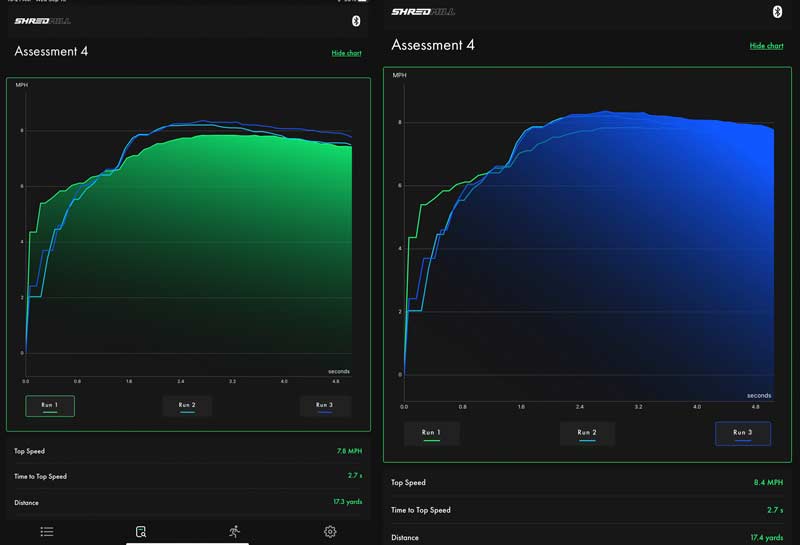
- Coaches can also use discretion when they do not want a rep to be captured to an athlete’s profile by using the “free run” feature. Here, the coach has the ability to set the resistance, incline, and duration of repetition. Data will still be shown, but not saved. I have found this valuable for technical sessions, determining athlete readiness, using the SHREDmill for a different type of rep (bounding, single leg runs), or just trying something different with the settings that one thinks may help.
- You cannot outgrow it. The unique magnetic resistance increases as your speed increases. The harder you push, the harder it pushes back. This makes it a fantastic tool for novice through professional athletes.
- Most importantly, athletes love it! Athletes are excited at every session to hop on and see where they are at. As with timing sprints, athletes are also invested in their performance. Just this week, I had an athlete who hit over 10 mph on Gear 2 after flirting with it for a few sessions. A couple days later a teammate of his saw me in the hallway and said, “Athlete X called me and told me he got above 10 mph. He was PUMPED!”
Training
The SHREDmill came with a suggested training structure:
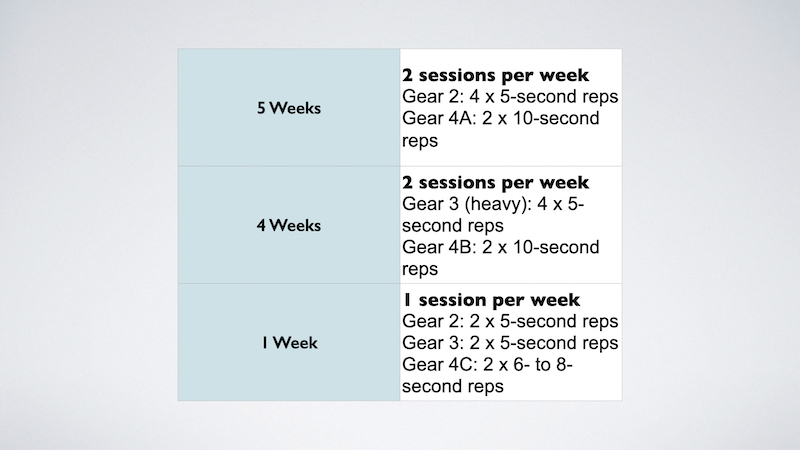
Coaches in the private sector know that consistency of training sessions with athletes can be a challenge. In my context, I meet with athletes once or twice per week, but I am always battling the other demands they have in their schedule (and my own).
I followed this guideline the best I could because I believe in the results that XPE and trainers like Josh McClure have produced. To accommodate the inconsistency in meetings with some athletes, I simply tallied their workouts. The first 10 SHREDmill sessions would be focused on Gear 2 while learning Gear 4. It took some athletes 10 or more weeks to get through that progression; others zipped through it in five weeks. In a strength and conditioning course in a school setting, or as part of sport season, athlete training should be more consistent, making this guideline more attainable.
A common approach to utilizing the SHREDmill effectively is utilizing circuits. This would especially be true in a large group setting. Here are a few examples.
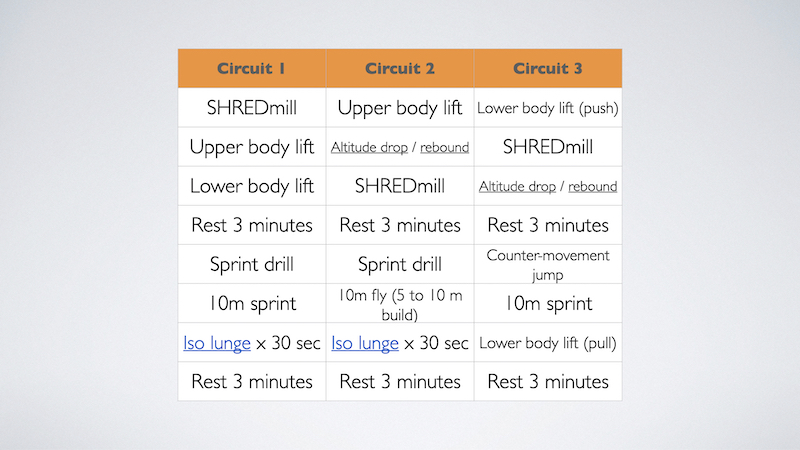
Regarding the table above, the number of cycles completed in a circuit is typically three or four and the SHREDmill placement is different in each. I have experimented with multiple sequences. Some athletes perform best when the SHREDmill is first; others respond well to a lift or plyometric immediately prior.
I kept the sprints and fly lengths short on purpose—if a lift is involved in the circuit, I personally would not go above a 20m sprint, and that 20m distance for me is at times questionable as evidenced by not including a lower body lift in Circuit 2, where there is a 10m fly with a 10m build. If I wanted to address maximum velocity in a session (3 to 60m blast/bleeds), I would almost always do it prior to a circuit or SHREDmill session.
Sprint drills are often a hot topic—I personally think they can have value if there is context. One concept which can be addressed in Gear 2 form is to create a big thigh split (opening scissors), followed by an aggressive close. This movement is found in speed bounding and acceleration wall switching. Circuits are a great way to link them to the task they are designed to assist.
In terms of data, two of the main metrics the SHREDmill captures are peak velocity and distance, so auto-regulation principles can be followed if desired; however, I have not been afraid to go beyond a traditional 3 to 5% drop early in the athlete’s exposure to the SHREDmill circuits. They can be a challenge initially, with athletes showing big drops during the third (or even second) cycle, but most develop an ability to handle the density fairly quickly.
In terms of data, two of the main metrics the SHREDmill captures are peak velocity and distance, says @HFJumps. Share on X-
- I constantly go back to this Boo Schexnayder quote from deep in the archives of the Just Fly Sports Podcast – Episode 14: “I am always looking for ways to subject my athletes to lactate in mild to moderate doses. In an acceleration development workout, if you hit the recoveries right, you’re getting speed and power development and restoration, all in one nice tight package; it’s like your birthday, it’s all there for you.”
- While I do not have the ability to test lactate levels, the outputs athletes show on the SHREDmill serve as a guide to how to adjust rest periods. I have also used heart rate to assist. After a few circuit sessions, the metrics rise and the athletes are able to complete more cycles at their new level. Win-win!
A common approach I use with my private clients is to allow them to chase PRs early in a session with full recovery between SHREDmill reps, followed by a circuit where outputs are still high despite fatigue setting in. If you are looking for high outputs, simply cut out exercises in the circuit and increase the rest. This will require you to be okay with loitering! Two go-to circuits for me are:
- Plyometric, SHREDmill, isometric lunge
- Altitude drop, SHREDmill, plyometric (hopping or bounding), isometric lunge
In my role in the private sector, most of the athletes I train are lifting outside of their meetings with me—because of that, we will not perform traditional strength work because it would be beating a dead horse. That being said, I do think there is magic that occurs with traditional strength work and the SHREDmill in the same session. Adding in plyometrics and drills which link to specific skills create a workout with a huge bang for your buck.
One weakness in comparing the SHREDmill to a motorized variable resistance/assistance device is the inability of the SHREDmill to access precise decreasing resistance in a single rep. I feel this is a powerful stimulus for athletes after initial exposure to traditional resisted sprints. One work-around here is utilizing Bullet Belt release sprints. I am in the early stages of using this with a handful of athletes, but the results have been promising. Another possibility was recently pointed out to me by Josh McClure: manually lowering the resistance while the athlete is completing a repetition. The switch could happen after a specific time or number of contacts. I am excited to give this a try!
Looking Back
I feel like I did quite a bit of research when I was looking for a tool to upgrade the services I could provide clients; however, I took a substantial risk purchasing a SHREDmill because I’d never used one.
I am now 11 months in and I can say that I am 100% satisfied with my purchase. While no tool checks every single box, the SHREDmill certainly checked nearly all I needed for my small private training business, and there is no doubt that it does the same for large group settings as well. If you are ever in the Chicago-land area and want to give one a try, you are always welcome!
Since you’re here…
…we have a small favor to ask. More people are reading SimpliFaster than ever, and each week we bring you compelling content from coaches, sport scientists, and physiotherapists who are devoted to building better athletes. Please take a moment to share the articles on social media, engage the authors with questions and comments below, and link to articles when appropriate if you have a blog or participate on forums of related topics. — SF

